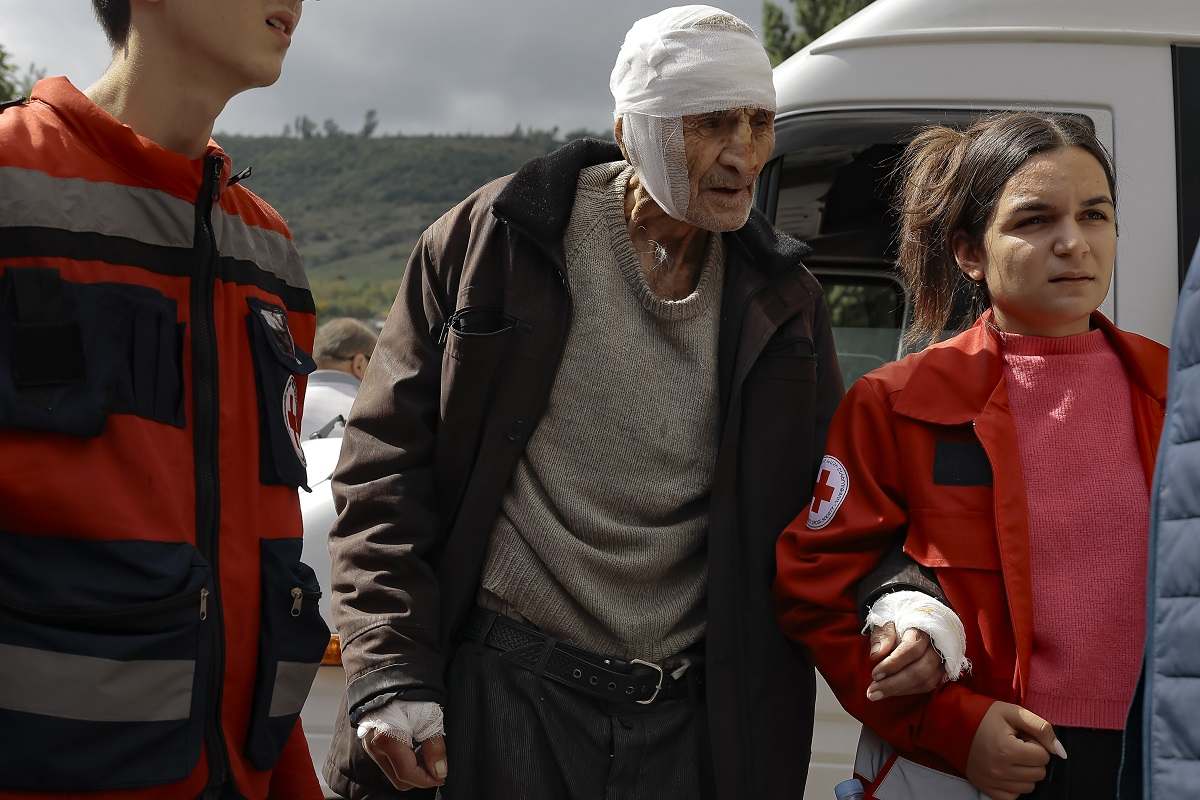Half of Nagorno-Karabakh’s Population Flees as the Separatist Government Says It Will Dissolve

Wounded ethnic Armenian man named Sasha, 84 years-old, from Stepanakert, Nagorno-Karabakh is helped by volunteers walk as he arrives in Armenia’s Goris in Syunik region, Armenia, on Wednesday.
17:35 JST, September 28, 2023
YEREVAN, Armenia (AP) — The separatist government of Nagorno-Karabakh announced Thursday that it will dissolve itself and the unrecognized republic will cease to exist by the end of the year, and Armenian officials said more than half of the population has already fled.
That is after Azerbaijan carried out a lightning offensive to reclaim full control over its breakaway region and demanded that Armenian troops in Nagorno-Karabakh lay down their weapons and the separatist government dissolve itself.
A decree to that effect was signed by the region’s separatist President Samvel Shakhramanyan. The document cited an agreement reached last week to end the fighting under which Azerbaijan will allow the “free, voluntary and unhindered movement” of Nagorno-Karabakh residents and disarm troops in Armenia in exchange.
Nagorno-Karabakh is a region of Azerbaijan that came under the control of ethnic Armenian forces, backed by the Armenian military, in separatist fighting that ended in 1994. During a six-week war in 2020, Azerbaijan took back parts of the region along with surrounding territory that Armenian forces had claimed during the earlier conflict.
Following the latest offensive and a cease-fire agreement brokered by Russian peacekeepers, Azerbaijan and Nagorno-Karabakh separatist authorities have begun talks on “reintegrating” the region back into Azerbaijan. Azerbaijani authorities have pledged to respect the rights of ethnic Armenians in the region and restore supplies after a 10-month blockade. Many local residents, however, fear reprisals and have decided to leave for Armenia.
By Thursday morning, more than half of Nagorno-Karabakh’s population — 66,500 people — had fled to Armenia, and the influx continues with unabating intensity, according to Armenian officials.
The massive exodus began on Sunday evening, and the only road linking Nagorno-Karabakh to Armenia quickly filled up with cars that created an hourslong traffic jam. On Monday night, a fuel reservoir exploded at a gas station where people seeking to leave were lining up for gas that due to the blockade had been in short supply. At least 68 people were killed and nearly 300 injured, with over 100 more still considered missing.
It isn’t immediately clear if any of the ethnic Armenians that have populated the region will remain there. Shakhramayan’s decree on Thursday urged Nagorno-Karabakh’s population — including those who left — “to familiarize themselves with the conditions of reintegration offered by the Republic of Azerbaijan, in order to then make an individual decision about the possibility of staying in (or returning to) Nagorno-Karabakh.”
On Thursday, Azerbaijani authorities charged Ruben Vardanyan, the former head of Nagorno-Karabakh’s separatist government who was arrested a day earlier, with financing terrorism, creating illegal armed formations and illegally crossing a state border.
Azerbaijani officials said Vardanyan, a billionaire who made his fortune in Russia, was detained as he was trying to cross into Armenia from the breakaway region along with thousands of others. He was escorted to Azerbaijan’s capital, Baku. His arrest appeared to indicate Azerbaijan’s intention to quickly enforce its grip on the region.
Vardanyan moved to Nagorno-Karabakh in 2022 and served as the head the regional government for several months before stepping down earlier this year.
"News Services" POPULAR ARTICLE
-

American Playwright Jeremy O. Harris Arrested in Japan on Alleged Drug Smuggling
-

Japan’s Nikkei Stock Average as JGB Yields, Yen Rise on Rate-Hike Bets
-

Japan’s Nikkei Stock Average Licks Wounds after Selloff Sparked by BOJ Hike Bets (UPDATE 1)
-

Japan’s Nikkei Stock Average Buoyed by Stable Yen; SoftBank’s Slide Caps Gains (UPDATE 1)
-

Japanese Bond Yields Zoom, Stocks Slide as Rate Hike Looms
JN ACCESS RANKING
-

Keidanren Chairman Yoshinobu Tsutsui Visits Kashiwazaki-Kariwa Nuclear Power Plant; Inspects New Emergency Safety System
-

Imports of Rare Earths from China Facing Delays, May Be Caused by Deterioration of Japan-China Relations
-

University of Tokyo Professor Discusses Japanese Economic Security in Interview Ahead of Forum
-

Japan Pulls out of Vietnam Nuclear Project, Complicating Hanoi’s Power Plans
-

Govt Aims to Expand NISA Program Lineup, Abolish Age Restriction























